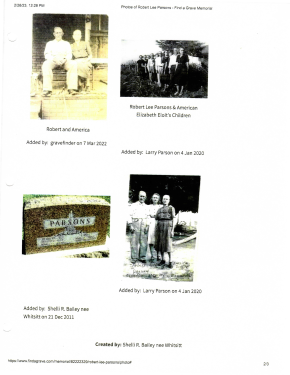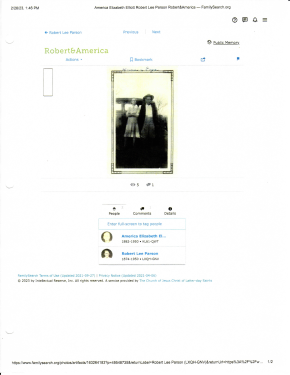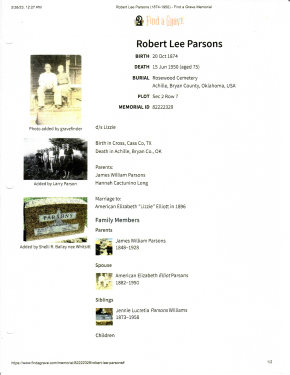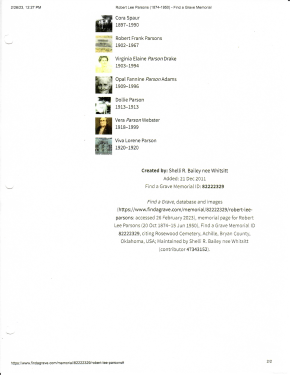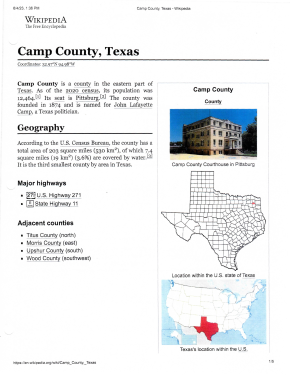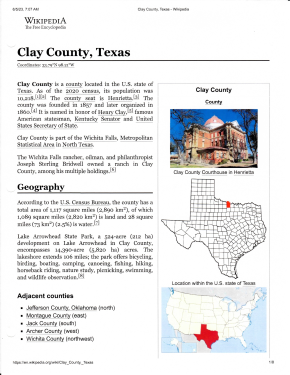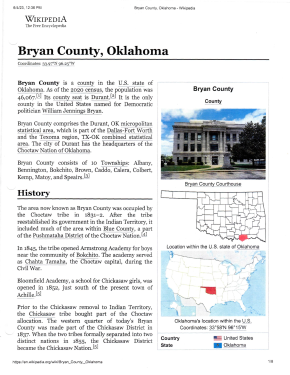For Elizabeth
The Parson Family Story
Chapter 04
Introduction
Chapter 1
Chapter 2
Chapter 3
Chapter 4
Chapter 5
Chapter 6
Helen's Benediction
Wynn Haynie
PHOTOS
Stories and Tales
(Mostly True)
Great Great Grandparents
Robert Lee Parsons
And
America Elizabeth Elliot Parsons
Click
for Larger
Robert Lee Parsons was your
Great Great Grandfather. His father, James William and his mother,
Catherine had traveled west from Independence, Arkansas to Cass
Co., Texas around 1874 with their two young children, Joseph
Alexander and Jennie Lucretia. It was there that their third
child, Robert Lee was born on Oct. 20, 1874.Texas had become a state in on December 29, 1845 and Cass Co. was formed in 1846, only twenty-eight years before Robert Lee was born. It was an Anglo settlement that began in the 1830’s and is located one county south of the northernmost corner of northeast Texas just southwest of present-day Texarkana.
Ulysses S. Grant was President of the United States and reconstruction had been very difficult in all of the southern states, driving many southerners westward again.
At the time Robert Lee was born, his father and mother, James William and Catherine Parsons were both twenty-six years old. Catherine died two years after Robert Lee was born, in 1876, at the age of twenty-eight. The railroads had begun to make their thunderous way across the vast and empty prairies of Texas also in 1876, bringing an ever larger opportunity for farmers like Robert Lee’s father to dream of new and larger fields to plow.
Unable to locate either his father, James William, or Robert Lee on an 1880 census record, he would have been six years old at that time. Five years after Catherine’s death, the thirty-three year old widowed father of three young children, James William was married to Charity P. (Lula) Lantroop in 1881.
Lula was born on October 4, 1857 also in Texas. When she married Robert Lee she was twenty-four years old. Robert Lee’s children, Joseph Alexander, Jennie Lucretia, and Robert Lee were ages twelve, nine, and seven. At this time they were living in Precinct 1, Camp, Texas. James William and Lula apparently never had any children of their own but they raised these three children together until James William died in 1928, at that time having been married for forty seven years.
With the 1890 census records being nonexistent, we do know that Robert Lee would have been sixteen at that time and probably living in Collin Co. Texas or one of the counties along the Red River.
He married America Elizabeth Elliott on September 13t 1896 in Collin Co., Texas. At the time, Robert Lee (Bob) was almost twenty-two and America Elizabeth (Lizzy) was fourteen. Lizzy had been born on February 10, 1882 in McKinney, Texas. Together, they had thirteen children, two of which died in infancy. Their first eight children were born in Collin Co., Texas, and their next five children were born in Bryan Co., Oklahoma. Their fourth child, and first son, Robert Frank, was your Great Grandfather, much more of which will be said later.
Of these thirteen children only three were boys.
Children of Robert Lee and America Elizabeth Parson
Cora
Kathleen: Born 1897. Died 1990. Age 93.
Lula Jane: Born 1898. Died 1970. Age 72.
Eula Mae: Born 1900. Died 1985. Age 85.
Robert Frank: Born 1902. Died 1967. Age 65.
Virginia Elaine (Lena): Born 1903, died 1994. Age 91.
John Lee: Born 1906. Died 1981. Age 75.
Ora Della: Born 1907. Died 1937. Age 30.
Fannie Opal: Born 1908. Died 1996. Age 87.
Clara Belle: Born 1911.Died sometime after 1990.
Dolly: Born 1913. Died 1913.
Harvey Eugene: Born 1914. Died 1982. Age 68.
Vera: Born 1918. Died 1999. Age 81.
Viva Lorene: Born 1920. Died 1920.
Of these thirteen children,
Elizabeth, seven were still living when you were born.
Extraordinary!Lula Jane: Born 1898. Died 1970. Age 72.
Eula Mae: Born 1900. Died 1985. Age 85.
Robert Frank: Born 1902. Died 1967. Age 65.
Virginia Elaine (Lena): Born 1903, died 1994. Age 91.
John Lee: Born 1906. Died 1981. Age 75.
Ora Della: Born 1907. Died 1937. Age 30.
Fannie Opal: Born 1908. Died 1996. Age 87.
Clara Belle: Born 1911.Died sometime after 1990.
Dolly: Born 1913. Died 1913.
Harvey Eugene: Born 1914. Died 1982. Age 68.
Vera: Born 1918. Died 1999. Age 81.
Viva Lorene: Born 1920. Died 1920.
The 1898 Land Rush proved to be the opportunity that the newly married couple had been dreaming of and they packed up their belongings and moved from Texas to Oklahoma where they would remain for many years. The beginning years of Bob and Lizzy’s marriage also coincided with the beginning of a new century; one which would bring more changes to their America than any other generation had ever witnessed.
In 1900, Bob, age twenty-six, and Lizzy, age eighteen were the parents of three young children; Cora, age three, Lula, age two, and Eula, an infant. They were most likely living in the area of McKinney, Texas in Collin, Co.
Much was changing in their America. In 1901, President McKinley was assassinated and Theodore Roosevelt became the twenty-sixth President of the United States. In 1903, the Wright Brothers had made their first flight at Kitty Hawk, and by 1907, Oklahoma had become a state and the Model T was traveling down the backroads of America. BY 1910, Bob, age thirty-six and Lizzy, age twenty-eight had eight children and were living in Kemp, Bryan Co., Oklahoma. Cora was thirteen, Lula was twelve, Eula was ten, Frank was eight, Lena was seven, John was four, Ora was three, and Opal was two.
The early settlers to this region, had been coming to the area since the 1880’s and had greatly increased after the Oklahoma Land Rush of 1889. Oklahoma had now been a state for three years. Located in Bryan Co., Kemp, now known as Hendrix, is located less than one mile from the Red River. This area was originally known as Warner Springs because of the spring water it provided to the early settlers. Most of these early settlers belonged to the Chickasaw tribe. Between1908 and 1910, the Missouri, Oklahoma and Gulf railway had built tracks through the area on the way south to Texas, bypassing, by several miles, the town of Kemp. For the first half of the twentieth century the town had two names, Hendrix (it’s postal designation) and Kemp City. In 1911, the community had a telephone exchange, a sawmill, three merchants, a saloon, a barber, a livery stable, a contractor, and a real estate office. North of town, the Bloomfield Indian School and Seminary still operated. The town was a trade center for fifteen to seventeen square miles of prime agricultural land that produced large crops of cotton and corn. The economy was based primarily on agriculture. In 1916, a tornado destroyed most of the town, including the bank, and killed many residents. Although some businesses did not rebuild, many did. By 1920, the population stood at one hundred thirty and had a telephone company, three general stores, two grocers, three physicians, a drugstore, an undertaker, a blacksmith, a cotton gin, and a hotel.
The gathering storm was beginning to brew in Europe and Bob and Lizzy’s America was about to change once again. In 1914, World War | began and by 1917 the United States had entered the fray. This war began when Austrian Archduke Ferdinand was assassinated by a Serbian rebel and The Austrian-
Hungarian Empire declared war on Serbia. This war was fought primarily over territory after Germany’s rise to power after the Franco-Prussian War of 1817. The Allied Powers; Great Britain, France, Italy, Romania, Japan, and eventually the United States fought against the Central Powers; Germany, Austria-Hungary, Bulgaria, and the Ottoman Empire. Tensions had been brewing throughout Europe after Germany’s reunification and annexation of
French territories, thus upsetting the European balance of power. This led to alliances throughout the world who became involved because of Great Britain’s wide reaching colonization and dominance throughout the world.
World War I involved over thirty countries and over a period of four years left fifteen million people dead. It is not known how this “war to end all wars” affected the Parsons family, but it certainly must have had great impact on their lives.
Between 1917 and 1918 Robert Lee had signed up for the World War I Draft. According to his Draft Card, he was a self-employed farmer living in Hendrix, Bryan Co., Oklahoma. He was forty-three years old, 5ft. 4 in., 131 Ibs., with blue eyes. At this time, he had a wife and ten children, with all, but perhaps the oldest three, living at home. He and Lizzy were also expecting another child at this time. Not unexpectedly, he was not called to serve. The United States did not enter the war until 1917 after the German submarines torpedoed the “Lusitania,” killing one hundred twenty-eight American passengers and over a thousand from other countries. Only then, did President Woodrow Wilson declare war.
The war brought the new horrors of modern military technology, combat in the skies, chemical warfare, and the devastating effects of trench warfare. The war ended at 11:00 on November 11, 1918 with allied victory, seven and a half months after the United States had entered the war.
Our brave men, those who survived, returned home gassed, shell-shocked, with frozen feet having been rotted in the trenches, and devastating battle injuries. We honor them each year on Veteran’s Day. The United States had sustained more than 320,000 casualties in the First World War, including over 53,000 killed in action and 204,000 wounded. There were also over 63,000 non-combat related deaths, mainly due to the Spanish Flu Epidemic of
1918. From Oklahoma, 90,527 served, 1,064 died, 4,154 were wounded, and 502 were listed as missing in action.
The 1918 pandemic affected most of the civilized world including not only the battlefields of Europe but also, Oklahoma. In fact, it is believed to have begun forty miles north of the border between Oklahoma and Kansas on an army base in Kansas and spread rapidly throughout the globe.
Unable to find specific information on Bryan Co., it is documented that there were an estimated 100,000 cases of the Spanish Flu in Oklahoma with at least 7,500 deaths. It struck suddenly and savagely with horrifying results. The symptoms seem to have been much more horrific than the recent Covid Pandemic of 2020, and of course there were no antibiotics and few doctors and hospitals. The only treatment at that time was whiskey. By 1917, Oklahoma and three other states had banned the sale of alcohol and the Eighteenth Amendment to the United States Constitution was passed in January, 1919 and the country went dry at midnight, January 17, 1920. Medicinal use of alcohol was, however, allowed as it was so necessary to alleviate the suffering of those with the Spanish Flu.
World War | had ended in 1918 with an armistice agreement between the nations involved. This agreement, The Treaty of Versailles, did, indeed, end the global conflict among nations, but failed to ensure that it would be “the war to end all wars.” During the war years, there was also one other event that assuredly impacted the lives of all Americans. In 1901, Spindletop, in Nacogdoches Co. Texas, spewed its black gold and the oil boom began, forever changing both the landscape and culture of both Texas and Oklahoma. It seems likely, from census records, that Robert Lee’s uncle, Dewitt Cleveland Parsons was one of these early oil drillers. This decade must have been the most difficult decade of Bob and Lizzy’s life. How strong they both had to have been to see their family safely through these harrowing years.
By1920, Bob, age forty-six and Lizzy, age thirty eight probably still had six of their eleven children living at home and the children were going to school in Yarnaby. John was fifteen, Ora was fourteen, Opal was thirteen, Clara was eleven and Harvey was seven. Only Vera was still too young to go to school. Lena was seventeen and may have not yet graduated but the oldest four children had all by this time graduated and were perhaps married and starting families of their own.
The pandemic had begun to subside and everyone just wanted a return to normal. The Nineteenth Amendment to the United States Constitution was passed on August 18, 1920 giving women the right to vote. Lizzy probably voted in her first election the following November, between Warren Harding and Calvin Coolidge.
The wartime economic boom had collapsed and the United States was in a deep economic recession. A vote for Harding meant a return to “Normalcy” and Harding won a landslide victory. It is probable, without a doubt, that both Bob and Lizzy voted for Republican Senator Warren G. Harding from Ohio.
As they tried to return to their normal lives, as did most Southerners, they were very likely little affected by the excessive debauchery of this decade, known as the “Roaring 20’s.” Inflation was at a near zero level, and life did seem to return to the more predictable pace of the past. Crops were planted and harvested, and many of Bob and Lizzy’s children were grown and starting families of their own. Little did they see the disaster on the horizon.
As this decade rolled along, Oklahoma experienced not only a severe drought but also the opening of the East Texas oil fields which created a petroleum glut and caused rapidly falling oil prices and extensive unemployment. Banks that had been quick to loan money and rapidly invest their deposits in the stock market began to fail after “Black Friday,” October 29,1928. The stock market crashed and small farmers, like Robert Lee, struggled to find the funds to buy seed to plant in the dry, cracked, increasingly depleted soil. In the 1930 Census, Bob and Lizzy were still living in Kemp, Bryan Co., Oklahoma. Bob was fifty-six and Lizzy was forty-eight. He was listed as the white, Head of Household and although their two youngest children, Harvey and Vera, would have only been sixteen and twelve, there are no other persons noted on this census form., Bob and Lizzy continued on, dry-land farming with a mule and a plow, with a steady resolve and determination. Neither the 1929 Stock Market Crash nor the 1935 Dust Bowl would lessen their love for the land. The Parsons’ family may have been battered by the depression and the dust bowl, but they remained undefeated. Their values of independence and hard work brought them through this decade, as it would in the decades to come.
The 1940 census shows them still living in Kemp, Bryan Co., Oklahoma. Bob, age sixty-six and Lizzy, age fifty-eight, had been living in the same house since 1935. It was located back in the woods in a small clearing; a small, probably two-room structure with a wide front porch on which sat a rocking chair, a bench, and several coon hounds. Lizzy’s kitchen looked only insignificantly different than the open campfires on which she had cooked on during their journey west. Running water and electricity were new and unlikely to have reached into the rural backwoods until the 1950’s.
The 1950 Census shows Bob, age seventy-six, and Lizzy age sixty-eight still living in Bryan Co., Oklahoma. Bob died on September 15, 1950 and is buried at Rosewood Cemetery in Achille, Bryan Co., Oklahoma. He and Lizzy had been married for fifty four years. He was seventy-six years old. It appears that, after Bob’s death, Lizzie, then sixty-eight years old, went to live with her youngest son Harvey in Lawton, Oklahoma. She soon followed Bob, and passed away on August 21, 1950. She is buried beside him in Rosewood Cemetery in Achille.
The events of his lifetime are remembered in the sounds so often recalled: the slow plodding of a mule’s hooves as it pulls a burdensome plow; the racing, thunderous hoof-beats of horses as their riders race to stake a claim; the lonely whistle of the first trains hauling cattle to the stockyards, the forlorn tolling of church bells ringing out the announcement of each new death during the pandemic; the howling sound of a tornado as it moves ever closer; all are reminiscent of the generation in which Bob and Lizzy Parsons lived their lives.
Cllick for Larger
Rabbit
Holes
Robert Lee and America Elizabeth Parsons
Rabbit Holes
America Elizabeth Elliot Parsons
America Elizabeth Elliot Parsons
was your Great Great Grandmother. She was born on February 10,
1882 in McKinney, Texas and died on August 21, 1950, at the age of
sixty-eight, in Lawton, Oklahoma. She is buried beside her husband
Robert Lee (Bob) Parsons in Achille, Oklahoma. A small, but
mighty, woman, she and Bob had thirteen children, all but two of
them surviving infancy, and living long, productive lives.Robert Lee and America Elizabeth Parsons
Rabbit Holes
America Elizabeth Elliot Parsons
Lizzy’s father was Franklin F. Elliot, her Grandfather was James Elliot, her Great Grandfather was Francis Elliot, and her Great, Great Grandfather was Thomas Elliot, all of whom were born in Kentucky. Thomas’ mother was Arvis Jenkins whose mother was Sarah Cullen, both of whom were born in Maryland. Sarah’s mother and father were Margaret Ford and Mr. Cullen (first name unknown) who were from Ireland and had emigrated to America.
Thus, some of your Irish roots have been untangled!
Rabbit
Holes
The Patchwork Quilts
Standing in the middle of a
small clearing, the four small children gazed around them,
somewhat amazed by the quiet solitude and monotone landscape
surrounding them. A small, unpainted, wooden, two-room structure
stood in front of them. The small clearing, in which the house
stood, was a well-worn area of dirt surrounded by trees and only
dimly penetrated by the fading summer sun. Two old ford vehicles;
one a car and one a truck, both also a dusty monochrome, were
parked at the edge of the clearing.The Patchwork Quilts
Even at their young age, they realized they had taken a step back in time. These Parsons children; Carole, age five, Ron, age four, and the twins, Paula and Paulette, age three had come to visit your Great Great Grandparents, Bob and Lizzy Parsons. They have no other memories of meeting them, so this was an important visit. As they gazed around them, they focused on the wide front porch attached to the small structure. There stood their Great Grandpa Bob; a small balding man with bright blue, twinkling eyes and a bit of a slanted smile, and Great Grandma Lizzy, a tiny woman with her thin, graying hair pinned on the top of her head quietly waving at them.
They fit well into their monochromatic surroundings; Bob, dressed in a white shirt and dark trousers held on his small frame with suspenders, and Lizzy, even smaller, her own tiny frame dressed in a dark, calf length muslin dress and ankle high black boots, happily welcoming the four, rather timid, children up onto the porch.
As they inched their way shyly forward, they each took note of different things. Carole, the most out-going of the four, swooped in on Great Grandpa Bob, instantly charmed by those twinkling eyes; Paulette, had an instant affinity with Great Grandma Lizzy; Ron headed instantly for the Coonhound stretched out lazily on the porch; and Paula, too timid to approach the Great Grandparents, stared intently at the bits of color she had spotted.
There, on the porch, were two quilts, both brightly colored. Scraps of fabric carefully hoarded and saved from muslin flour sacks and lovingly sown together by Lizzy. The quilts were colorful and beautiful. One was carefully folded and placed over the sagging cane bottom of the large old hand-hewn rocking chair and the other casually draped over the simple long bench placed on the other side of the porch behind the sleeping hound.
Their parents, Frank and Helen Parsons stepped up on the crowded porch and the children instantly scattered. Running out into the dirt-filled clearing they were relieved to be away from the slightly awkward position of meeting family members they had little knowledge of and were eager to run and shout in the dirt yard when suddenly, Carole stepped on an old, very rusty nail. It had penetrated rather deeply and her screams shattered the relative silence of the small enclosure.
Frank quickly ran and picked her up, where he deposited her swiftly onto Helen’s lap on the porch step as he gently removed and saved the rusty nail.
Bob had quickly grabbed a pail of water and Lizzy a clean white undergarment and ointment and the crying five year old was quickly administered to and placed in the front seat of the old ford on Helen’s lap; the other three children were placed in the backseat and off they sped to get a tetanus shot from old Doc Bolinger.
Thus ended the meeting of the four young children and their Great Grandparents. Not forgotten, is the cheerful color of the two old quilts laying brightly amid the otherwise monochromatic landscape.
Geography
Of The Parsons Clan
Tangopappa.com
Rights Reserved
